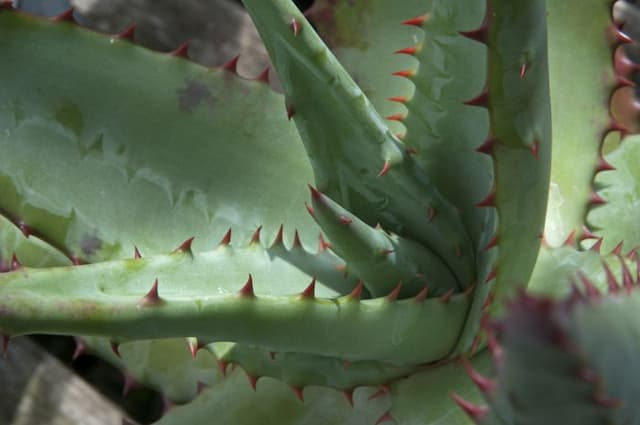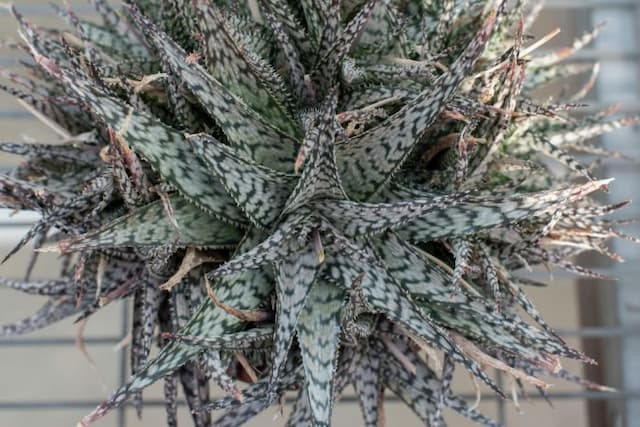Variegated Candelabra Aloe Aloe arborescens 'Variegata' (v)

ABOUT
The Aloe arborescens 'Variegata', commonly known as the variegated candelabra aloe, features striking, fleshy leaves that form a rosette pattern. As suggested by the name "variegata," its leaves are characterized by a striking variegation pattern where creamy white or pale yellow stripes and edges contrast beautifully with the green background. Margins of the leaves are adorned with small, gentle teeth, which give texture to the overall appearance of the plant. These teeth can sometimes show a reddish tinge, which adds to the visual interest of the plant. The leaves are also slightly recurved, curving back towards the ground, adding to the plant’s graceful and arching structure. The variegated candelabra aloe is also known for its flowers, which emerge on tall, branched stalks rising above the foliage. The flowers are typically a vibrant orange or red color, providing a striking display that is especially visible when in contrast against the variegated leaves. Overall, the variegated candelabra aloe's unique pattern of leaf variegation and dynamic flowering stalks make it a distinctive and ornamental plant, highly prized in gardens and collections for its stunning visual appeal and ease of care.
About this plant
 Names
NamesFamily
Asphodelaceae.
Synonyms
Variegated Candelabra Aloe, Variegated Krantz Aloe, Variegated Tree Aloe.
Common names
Aloe arborescens 'Variegata'
 Toxicity
ToxicityTo humans
The variegated aloe, also known simply as aloe, has parts that are considered toxic if ingested by humans. The latex—the yellowish substance found just under the skin of the leaves—contains anthraquinones, which have a laxative effect. Consumption of the latex can lead to diarrhea, abdominal cramps, and dehydration. In more severe cases, it may lead to electrolyte imbalances. It is generally recommended to avoid consuming any part of the aloe plant, especially for pregnant women, as there are reports that it can induce uterine contractions.
To pets
The variegated aloe contains saponins and anthraquinones that are toxic to pets if ingested. Symptoms of aloe poisoning in pets can include vomiting, diarrhea, depression, anorexia, tremors, and in rare cases, changes in urine color. Ingesting large amounts may lead to more severe reactions, including potential toxicity to the kidneys. It is best to keep this plant out of reach of pets and seek veterinary care if any contact or ingestion is suspected.
 Characteristics
CharacteristicsLife cycle
Perennials
Foliage type
Evergreen
Color of leaves
Variegated
Flower color
Orange
Height
3 feet (0.91 meters)
Spread
2 feet (0.61 meters)
Plant type
Succulent
Hardiness zones
9
Native area
South Africa
Benefits
 General Benefits
General Benefits- Ornamental Appeal: Aloe arborescens 'Variegata' has striking variegated leaves, adding visual interest to gardens and indoor spaces.
- Drought Tolerance: This plant is highly drought-resistant, making it ideal for xeriscaping and low-water gardens.
- Easy Care: It requires minimal maintenance, making it suitable for busy gardeners or those new to horticulture.
- Hardiness: The plant is quite hardy and can survive in a range of environmental conditions.
- Pest Resistance: It has a natural resistance to many common garden pests, reducing the need for chemical pesticides.
 Medical Properties
Medical Properties- Topical treatment for burns: The gel from the Aloe arborescens leaves is widely used for soothing minor burns, including sunburns.
- Skin moisturizer: The gel can also act as a skin moisturizer, helping to keep the skin hydrated and supple.
- Wound healing: It has properties that can aid in the acceleration of skin healing in cases of minor cuts and abrasions.
- Immune system support: Some studies suggest that Aloe arborescens can help support the immune system, though further research is needed.
- Antioxidant properties: The plant contains various compounds with potential antioxidant properties, which can help in protecting the body from oxidative stress.
 Air-purifying Qualities
Air-purifying QualitiesThis plant is not specifically known for air purifying qualities.
 Other Uses
Other Uses- Ornamental landscaping: Aloe arborescens 'Variegata' adds aesthetic appeal to gardens with its striking variegated leaves and can be used in rockeries, succulent gardens, or as a focal point in landscape designs.
- Privacy screens: Due to its dense growth habit, it can be planted in rows to create a natural and visually interesting privacy screen.
- Erosion control: Its root system can help stabilize soil on slopes, making it useful for erosion control in some environments.
- Container gardening: This aloe's ability to thrive in pots makes it suitable for balconies, patios, or indoors, adding a decorative touch whilst requiring minimal space.
- Culinary garnish: Though not commonly consumed, the vibrant variegated leaves may serve as an attractive edible garnish if properly cleaned and used sparingly due to their strong taste.
- Thematic gardens: Aloe arborescens 'Variegata' is a great addition to xeriscapes or drought-resistant themed gardens due to its low water requirements.
- Floral arrangements: The unique form and coloration of the leaves can add an exotic touch to both fresh and dried floral arrangements.
- Photography subject: The plant's distinct appearance makes it an interesting subject for botanical photography and art projects.
- Barrier planting: Its thick and spiky foliage can deter animals and humans from entering certain areas, making it useful for planting around property borders.
- Educational tool: This plant can be used to educate individuals about horticulture, particularly the care and propagation of succulents and variegated plants.
Interesting Facts
 Feng Shui
Feng ShuiThe Variegated Aloe is known for its healing properties and can be used in Feng Shui to promote health and well-being. It can be placed in the health area of the home, which is the east sector, to enhance the chi related to health and balance.
 Zodiac Sign Compitability
Zodiac Sign CompitabilityThe Variegated Aloe is not used in astrology practice.
 Plant Symbolism
Plant Symbolism- Healing and Protection: Aloe plants are commonly associated with their ability to soothe skin irritations and burns, symbolizing physical and spiritual healing.
- Patient Care: Aloe requires minimal water and maintenance, symbolizing the virtue of patience and the ability to thrive under care.
- Good Luck: In some cultures, aloe is believed to bring good luck and ward off negativity, similar to many indoor plants thought to purify air and energy.
- Beauty: The 'Variegata' variety, with its variegated leaves, particularly symbolizes beauty and uniqueness due to its striking patterns.
- Endurance: Because of Aloe's natural ability to survive in harsh conditions, it represents endurance and the power to withstand tough environments.
 Water
WaterThe variegated Aloe, also known as Krantz Aloe or Candelabra Aloe, should be watered deeply but infrequently to mimic its natural arid environment. Allow the soil to completely dry out before watering again, which typically means watering every 2-3 weeks. During the winter, reduce watering to once a month or less as the plant goes dormant. When you do water, do so until water runs freely from the drainage holes of the pot, which might be around 2-4 ounces for smaller pots or up to a gallon for larger ones, depending on the size of the container and the dryness of the soil.
 Light
LightThe variegated Aloe prefers bright light and some direct sun to maintain its vibrant coloration and strong growth. An ideal spot would be a south or west-facing window where it can get at least 6 hours of sunlight daily. However, it should be protected from intense midday sun in hot summer months to prevent leaf scorching.
 Temperature
TemperatureThe variegated Aloe thrives in temperatures between 60°F and 80°F, making it suited for most indoor environments. It can withstand temperatures down to about 40°F but should be protected from frost, as it is not frost-hardy. Ideally, it should not be exposed to temperatures below 50°F, as cold conditions can damage the succulent leaves.
 Pruning
PruningPruning your variegated Aloe should be done primarily to remove damaged or dead leaves, which will encourage healthy growth and prevent disease. The best time for pruning is in the spring or early summer. Minimal pruning is typically required, and it can be done as needed to maintain the plant's shape or to remove any offsets (pups) that can be repotted.
 Cleaning
CleaningAs needed
 Soil
SoilVariegated Aloe requires well-draining soil mix, combining two parts sand or pumice with one part potting soil or use a commercial cactus mix. The ideal soil pH for Variegated Aloe should be slightly acidic to neutral, around 6.0 to 7.5.
 Repotting
RepottingThe Variegated Aloe should be repotted every two to three years or when the plant has outgrown its pot, ensuring stable growth and health.
 Humidity & Misting
Humidity & MistingVariegated Aloe prefers dry air conditions and is quite tolerant of low humidity levels typical of indoor environments.
 Suitable locations
Suitable locationsIndoor
Place in bright, indirect light and avoid overwatering.
Outdoor
Sunny location, protect from frost, well-draining soil.
Hardiness zone
9-11 USDA
 Life cycle
Life cycleAloe arborescens 'Variegata', commonly known as variegated candelabra aloe, starts its life as a seed which germinates in warm, well-draining soil, typically during the warm spring or summer months. The seedling emerges with variegated leaves that showcase a striped pattern of white and green, and the plant begins to establish a small rosette. As it matures, the rosette grows and the plant develops its trademark succulent leaves, which store water and help it to survive in arid conditions. During the maturity stage, which may take several years, the plant will reach its full size, forming a large, branched structure with multiple rosettes. This aloe typically blooms in the winter, producing tall spikes of tubular orange-red flowers that attract pollinators. After many years, when the plant has completed its lifecycle, it may produce offsets or "pups" around its base, which can be detached and planted to start new plants before the parent plant eventually dies.
 Propogation
PropogationPropogation time
Spring-Early Summer
The most popular method of propagation for the Aloe arborescens 'Variegata', also known as variegated Aloe arborescens, is by using offsets, which are also commonly called pups. These pups usually appear around the base of the parent plant and can be removed during the spring or early summer when the plant’s active growth phase begins. To propagate, carefully separate the pup from the mother plant using a clean, sharp knife, making sure to include a portion of the root. Allow the cut pup to callous over for a day or two to prevent infection. Once calloused, plant the pup in well-draining soil and water lightly until established. It's essential to ensure that the soil is not kept too moist, as overwatering can lead to rot.









